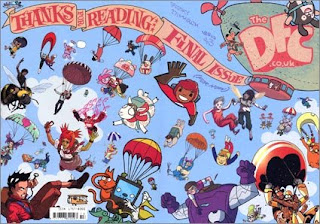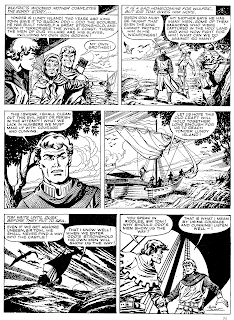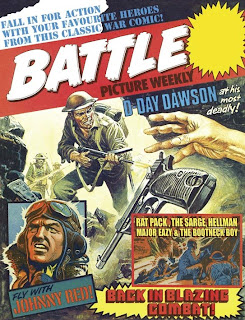
T. C. H. Jacobs was a man of many identities. As a writer he used various noms-de-plume: when writing Westerns he was Tom Curtis and Penn Dower; for romances he became Kathleen Carstairs, Helen Howard, Marilyn Pender or Anne Penn; in Holland he was known as Lex Pender (a name not otherwise used); and for one memorable novel he became James Stagg, actually a real author whose own novel was pulled suddenly and, rather than waste a cover, one by Jacobs' was substituted. In real life he was born Thomas Curtis Hicks Jacobs but was known to many as Jacques Pendower and, legally, became Thomas Curtis Hicks Pendower in January 1941.
Yet it was under his birth name that he is still best known. The byline T. C. H. Jacobs appeared on over 50 novels between 1930 and 1972, including the Temple Fortune series of private eye yarns as well as more traditional police procedurals featuring Chief Inspector Barnard and, separately, Detective Superintendant John Bellamy. It would be wrong to say that Jacobs is well known today and he has few collectors but at least one of his novels—a Temple Fortune yarn—was reprinted in the famous green livery of Penguin's crime paperbacks.
As Jacques Pendower he wrote another private eye series featuring Slade McGinty and, anonymously, he is reputed to have written scores of Dixon Hawke tales for D. C. Thomson. Bill Lofts credited him as "one of D. C. Thomson Group's leading Dixon Hawke writers", and said that he had written the bulk of the stories that appeared in the Dixon Hawke Casebooks, although I've yet to find any hard evidence of the fact. His contributions to the Hawke saga in the pages of
Adventure remain equally elusive, although
a collection of Jacobs' papers records one manuscript title ("The Double Trail") and notes that Jacobs corresponded with David Gilchrist, the editor of
Adventure, in January 1929 to January 1930, developing a Dixon Hawke serial which was eventually not published.
Even without this huge anonymous output, Jacobs was still a prolific writer: the bibliography below lists some 110 novels, plus other works and that is likely to be only scratching the surface. Jacobs himself claimed to have written over 180 novels, although some of these may be serials for magazines such as
Miracle. He also wrote short stories, non-fiction and features for newspapers and magazines, plays for the BBC, and comic strips and various juvenile series for children.
Thomas Curtis Hicks Jacobs was born in Plymouth, Devon, on 30 December 1899, the son of Robert Jacobs (a printer and paper merchant who was also an artist) and his wife Mary Thomas (neé Hicks), who had married in 1895. Jacobs was educated at Grammar School in Plymouth and was a keen storyteller from an early age: at the age of eight he produced his own, self-illustrated collection entitled
The Children's Book of Stories. He continued to entertain himself with writing during his childhood and was still only sixteen when his first published work appeared in the
Western Weekly News.
Jacobs served in the 15th London Regiment from 1917 and, in 1918, was wounded in action and taken prisoner. He escaped and remained with the Army as a second lieutenant until he was demobilized in 1921.
After the war, Jacobs joined the civil service revenue department as a revenue investigating officer. Jacobs was married to Muriel May Newbury on 1 June 1925 and a son, John, was born in 1927. He sold his first novel—written, he later recalled, through "economic necessity"—to A. J. Rhodes, the editor of the
Weekly Western News, in 1928, as well as writing articles about the landscapes and traditions of Dartmoor and its surroundings for the same paper in 1928-29. For the next twenty years, Jacobs would write at night whilst continuing to serve with the Inland Revenue.
In the 1930s, he contributed anonymously to the D. C. Thomson boys' papers
Rover and
Wizard and also to the rival Amalgamated Press paper
Triumph. After the Second World War, he continued to supply tales to A.P.'s comics, including serials featuring the character Hamilton Edward Shakespeare and Buffalo Bill to
Knockout and Tough Tempest to
Sun. He also turned his pen to writing comic strips and created two characters for the A.P.'s Australian line of comics, Thunderbolt Jaxon and Battling Samson.
His novel
Traitor Spy was filmed at Welwyn Studios in 1939 by Rialto Productions with Bruce Cabot and Marta Labarr as a pair of British agents who have tracked down a spy working in an anti-submarine patrol boat factory; the film featured Edward Lexy as Pendower's character Inspector Barnard and was released in the USA as
The Torso Murder Mystery.
Pendower, as he was now called, left the Inland Revenue in 1950 to write full-time and penned numerous short stories for the
Boy's Own Paper,
Evening News,
Edgar Wallace Magazine,
Argosy,
Parade,
Escort,
Master Detective and others in the 1950s, '60s and '70s, as well as contributing comic strip scripts to
Cowboy Adventure Library,
Western Adventure Library and
Combat Library in around 1963. He also wrote a Sexton Blake novel which was revised by James Stagg and published under the latter’s name in 1957 when the directors decided that the novels appearing in the
Sexton Blake Library under Howard Baker's editorship were too strong for Blake's supposed young audience. One of the novels already announced was
Panic in the Night by James Stagg. It was pulled and a novel Pendower had submitted appeared in its place, although still under Stagg's title and byline.
In 1953, he became a founding member of the Crime Writers Association and served as chairman in 1960-61. He was also a member of the Society of Civil Service Authors, the Press Club, the Radio and Television Guild, the Society of Authors and the Bexley Rotary Club.
Pendower lived in Bexley, Kent, for much of his life and died in 1976.
PUBLICATIONSNovels (series: Chief Inspector Barnard; Det. Supt. John Bellamy; Temple Fortune; Whip McCord; Jim Malone; Mike Seton)
The Terror of Torlands. London, Stanley Paul & Co., 1930.
The Bronkhorst Case. London, Stanley Paul & Co., 1931; as
Documents of Murder, New York, The Macaulay Company, 1933.
Scorpion's Trail (Barnard). London, Stanley Paul & Co., 1932; New York, The Macaulay Company, 1934.
The Kestrel House Mystery (Barnard). London, Stanley Paul & Co., 1932; New York, The Macaulay Company, 1933.
Sinister Quest (Barnard). London, Stanley Paul & Co., 1934; New York, The Macaulay Company, 1936; as
Die 7 Morde des Mr. X by Lex Pender, Amsterdam, Mertens & Stappaerts, 1954.
The 13th Chime (Barnard). London, Stanley Paul & Co., 1935; New York, The Macaulay Company, 1936.
Silent Terror (Barnard). London, Stanley Paul & Co., 1936; New York, The Macaulay Company, 1937.
Appointment with the Hangman. London, Stanley Paul & Co., 1936; New York, The Macaulay Company, 1936.
The Laughing Men (Barnard). London, Hodder & Stoughton, 1937.
Identity Unknown (Barnard). London, Stanley Paul & Co., 1938.
Traitor Spy (Barnard). London, Stanley Paul & Co., 1939.
Brother Spy (Barnard). London, Stanley Paul & Co., 1940.
The Broken Knife (Barnard). London, Stanley Paul & Co., 1941.
The Grensen Murder Case (Bellamy). London, Stanley Paul & Co., 1943.
Reward for Treason (Barnard). London, Stanley Paul & Co., 1944.
The Black Box (Barnard). London, Stanley Paul & Co., 1946.
The Curse of Khatra (Bellamy). London, Stanley Paul & Co., 1947.
With What Motive? (Bellamy). London, Stanley Paul & Co., 1948.
Dangerous Fortune (Fortune). London, Stanley Paul & Co., 1949.
The Red Eyes of Kali (Fortune/Barnard). London, Stanley Paul & Co., 1950; as
Die roten Augen des Kali by Lex Pender, Amsterdam, Mertens & Stappaerts, 1954.
Texas Stranger. London, Amalgamated Press (Western Library 6), Jun 1950.
Lock the Door, Mademoiselle (Fortune). London, Stanley Paul & Co., 1951.
Blood and Sun-Tan (Fortune). London, Stanley Paul & Co., 1952.
Lady, What's Your Game? (Fortune). London, Stanley Paul & Co., 1952.
Guns for Hire. London, Amalgamated Press (Western Library 59), Sep 1952.
Lone Adventure (McCord). London, Amalgamated Press (Western Library 75), May 1953.
No Sleep for Elsa (Fortune). London, Stanley Paul & Co., 1953.
Perilous Quest. London, Amalgamated Press (Western Library 90), Dec 1953.
Danger Riders (McCord). London, Amalgamated Press (Western Library 92), Jan 1954.
The Fourth Man. London, Amalgamated Press (Western Library 105), Aug 1954.
The Woman Who Waited. London, Stanley Paul & Co., 1954.
Good Knight, Sailor (Fortune). London, Stanley Paul & Co., 1954.
Death in the Mews (Fortune/Barnard). London, Stanley Paul & Co., 1955.
Results of an Accident (Bellamy). London, Stanley Paul & Co., 1955.
Cause for Suspicion. London, Stanley Paul & Co., 1956.
Broken Alibi (Bellamy). London, Stanley Paul & Co., 1957; New York, Roy Publishers, 1957.
Deadly Race (Fortune). London, John Long, 1958.
Black Trinity (Bellamy). London, John Long, 1959.
Women Are Like That (Fortune/Bellamy). London, Robert Hale, 1960.
Let Him Stay Dead (Malone). London, Robert Hale, 1961.
The Tattooed Man. London, Robert Hale, 1961.
Target for Terror (Seton/Fortune). London, Robert Hale, 1961.
The Red Net (Malone). London, Robert Hale, 1962.
Murder Market (Fortune). London, Robert Hale, 1962.
The Secret Power. London, Robert Hale, 1963.
Danger Money (Fortune). London, Robert Hale, 1963.
The Elusive Monsieur Drago (Seton). London, Robert Hale, 1964.
Final Payment (Fortune). London, Hale, Robert 1965.
Ashes in the Cellar (Fortune). London, Hale, 1966.
Sweet Poison (Fortune). London, Hale, 1966.
Death of a Scoundrel (Fortune). London, Hale, 1967.
Wild Week-End (Fortune). London, Robert Hale, 1967.
House of Horror (Fortune). London, Hale, 1969.
The Black Devil (Fortune). London, Hale, 1969.
Security Risk. London, Hale, 1972.
Novels as Kathleen CarstairsIt Began in Spain. London, John Gresham, 1960.
Third Time Lucky. London, John Gresham, 1962.
Shadows of Love. London, John Gresham, 1966.
Novels as Tom CurtisBandit Gold. London, Stanley Paul & Co., 1953.
Gunman's Glory. London, Stanley Paul & Co., 1954.
Trail End. London, Stanley Paul & Co., 1954.
Frontier Mission. London, Stanley Paul & Co., 1955.
Border Justice. London, Stanley Paul & Co., 1955.
Ride and Seek. London, Stanley Paul & Co., 1957.
Phantom Marshal. London, John Long, 1957.
Gun Business. London, John Long, 1958.
Lone Star Law. London, John Long, 1959.
Novels as Penn Dower (series: Brett Malone)
Long Star Ranger. London, John Long, 1952.
Bret Malone, Texas Marshal (Malone). London, John Long, 1953.
Gunsmoke Over Alba. London, John Long, 1953.
Texas Stranger. London, John Long, 1954.
Indian Moon. London, John Long, 1954.
Malone Rides In (Malone). London, John Long, 1955.
Two-Gun Marshal. London, John Long, 1956.
Desperate Venture. London, John Long, 1956.
Guns in Vengeance. London, John Long, 1957.
Frontier Marshal. London, John Long, 1958.
Bandit Brothers. London, Four Square Books, 1964.
Novels as Helen HowardPoisoned Love. London, John Gresham, 1960.
Ladder of Love. London, John Gresham, 1966.
Novels as Marilyn PenderThe Devouring Flame. London, John Gresham, 1960.
A Question of Loyalty. London, John Gresham, 1961.
The Golden Vision. London, John Gresham, 1962.
Rebel Nurse. London, John Gresham, 1962.
Dangerous Love. London, John Gresham, 1966.
Novels as Jacques Pendower (series: Slade McGinty)
Hunted Woman. London & Melbourne, Ward, Lock & Co., 1955.
The Dark Avenue. London & Melbourne, Ward, Lock & Co., 1955.
Mission in Tunis. London, Robert Hale, 1958; New York, Paperback Library, 1967.
The Long Shadow. London, Robert Hale, 1959.
Double Diamond. London, Robert Hale, 1959.
Anxious Lady. London, Robert Hale, 1960.
The Widow from Spain. London, Robert Hale, 1961; as
Betrayed, New York, Paperback Library, 1967.
Death on the Moor. London, Robert Hale, 1962.
The Perfect Wife (McGinty). London, Robert Hale, 1962.
Operation Carlo (McGinty). London, Robert Hale, 1963.
Sinister Talent (McGinty). London, Robert Hale, 1964.
Master Spy (McGinty). London, Robert Hale, 1964.
Spy Business. London, Robert Hale, 1965.
Out of This World. London, Hale, 1966.
Traitor's Island (McGinty). London, Hale, 1967.
Try Anything Once. London, Hale, 1967.
A Trap for Fools. London, Robert Hale, 1968.
The Golden Statuette. London, Hale, 1969.
Diamonds for Danger. London, Hale, 1970.
She Came by Night. London, Hale, 1971.
Cause for Alarm. London, Hale, 1971.
Date with Fear. London, Hale, 1974.
Novels as Anne PennDangerous Delusion. London, John Gresham, 1960.
Prove Your Love. London, John Gresham, 1961.
Mystery Patient. London, John Gresham, 1966.
Novels as James Stagg [revised by James Stagg]
Panic in the Night. London, Amalgamated Press (SBL 3/377), Mar 1957.
Collections published anonymouslyNote: Jacobs was reputedly the primary author of the Dixon Hawke Casebook but it is certain that other authors contributed stories.Dixon Hawke Casebook. Dundee, D. C. Thomson, 20 vols., 1938-52.
Non-fictionCavalcade of Murder. London, Stanley Paul & Co., 1955.
Pageant of Murder. London, Stanley Paul & Co., 1956.
Aspects of Murder. London, Stanley Paul & Co., 1956.
Radio PlaysThe Grensen Murder Case (BBC).
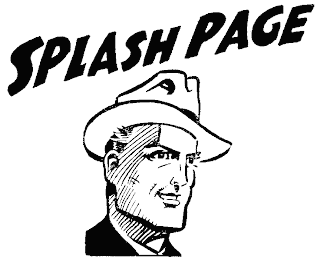 The release of The Casebook of Sexton Blake has prompted me to dig out this example of a Sexton Blake spin-off strip. Blake featured in Knockout from 1939-60 and in Valiant in 1968-70. A later revival stumbled at the last minute: Blake was meant to be the lead strip in Tornado when it launched in 1979 but the failure of the Sexton Blake TV series Sexton Blake and the Demon God in late 1978 led the editors to change Blake into a new character called Victor Drago. A real shame as it was the most true-to-character Blake strip ever.
The release of The Casebook of Sexton Blake has prompted me to dig out this example of a Sexton Blake spin-off strip. Blake featured in Knockout from 1939-60 and in Valiant in 1968-70. A later revival stumbled at the last minute: Blake was meant to be the lead strip in Tornado when it launched in 1979 but the failure of the Sexton Blake TV series Sexton Blake and the Demon God in late 1978 led the editors to change Blake into a new character called Victor Drago. A real shame as it was the most true-to-character Blake strip ever.
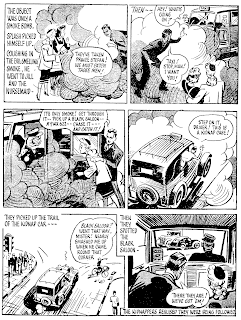
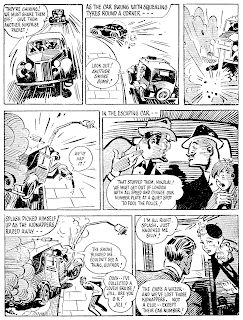
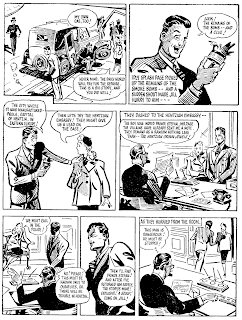
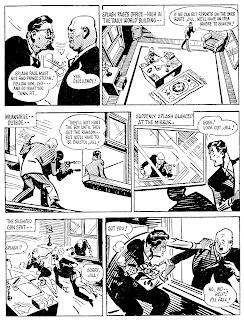
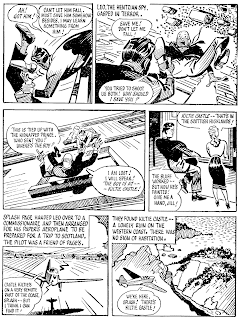
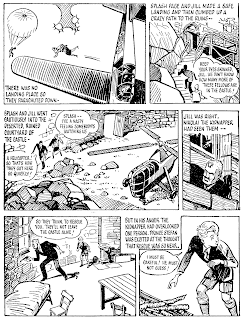
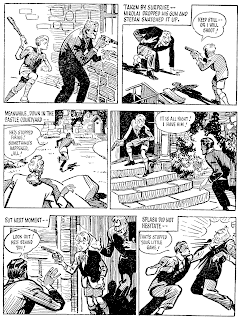
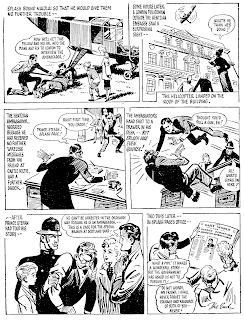 (* Splash Page © IPC Media)
(* Splash Page © IPC Media)


















